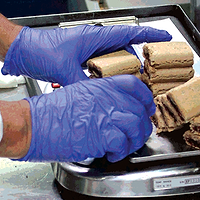Using the C-A-S-H System in Retail Operations

There is a heightened sense of urgency surrounding the implementation of food safety programs at retail locations. Keeping the message to employees simple and repeating it frequently is a strategy that will result in a positive safe food image for the store operator.
Nearly 25 years ago, the Food Marketing Institute (FMI) developed the M.U.S.T. (Management Uniform Sanitation Training) program to help the grocery industry communicate the importance of food safety to in-store food handlers. The program teaches the acronym C-A-S-H as a mnemonic device to help store associates remember the four key messages to maintaining food safety—Climate, Avoidance, Sanitation and Hygiene-—and to make clear the message that protecting the quality of the food offered at food retail stores equates to sales.
This approach to putting food safety principles into place within the retail environment advocated by FMI a quarter-century ago, and continues to promote today, is aimed at keeping the food safety message simple for employees and customers alike. According to Frank Yiannas, manager of Walt Disney World's Food Safety & Health Department, "When it comes to food safety messages, I believe that sometimes less is more. An effective food safety message can take a complex scientific truth and make it simpleeasy to understand, apply and remember."
Simplicity also is crucial to having food safety principles followed consistently. Once a store manager understands the processes and actions of the company's associates, it becomes his or her responsibility to build food safety principles into the associates' activities. Operators who have effective food safety programs have been successful in communicating the message to their key associates and putting the message into practice.
Defining C-A-S-H
 Each of the C-A-S-H components represents an important aspect of food safety. Controlling the temperature of the food during the time it is within the retail facility will have an important effect on the safety of the product. Avoiding situations that will render food unwholesome is the responsibility of the operator. Eliminating harmful bacteria through proper sanitation practices is essential to ensure that potentially harmful products do not reach the consumer. In addition, the hygiene of the food handlers must be controlled to minimize the opportunity for contamination.
Each of the C-A-S-H components represents an important aspect of food safety. Controlling the temperature of the food during the time it is within the retail facility will have an important effect on the safety of the product. Avoiding situations that will render food unwholesome is the responsibility of the operator. Eliminating harmful bacteria through proper sanitation practices is essential to ensure that potentially harmful products do not reach the consumer. In addition, the hygiene of the food handlers must be controlled to minimize the opportunity for contamination.
Retailers must address all four of these components of food safety in order to avoid any potential contamination or spoilage issues:
Climate. Temperature is one of the most important factors in controlling microbial growth at the retail level. In the store, temperature control occurs in fixed locations and during food preparation. Such fixed locations include reserve coolers and freezers, as well as the hot and cold display cases on the sales floor. Food placed in a properly operating fixed location with the ability to maintain food at the correct temperature allows the operator to limit the growth of microbes. When food arrives at the store level, it is critical to receive the products quickly; first making the decision to receive if the food meets the retailer's food safety and buying specifications, and then moving the food to a fixed location. This process must always be conducted in a manner that maintains the temperature integrity of the food.
There are many opportunities for prepared food to be exposed to temperature ranges that may either encourage or discourage bacterial growth. Food must be moved from one temperature environment to another without allowing it to be contaminated by potentially harmful bacteria or to elevate resident microbe populations. An operator should analyze the process step in the preparation of food to ensure that any amount of time the product spends out of a temperature-controlled environment is limited. If the process calls for a cooking step, there is an opportunity to destroy bacteria if the step is conducted properly. A chill step also can hinder bacterial growth if it is conducted properly. Hot and cold holding devices offer the last opportunity to help the retailer control the growth of microbes during the time the food is offered for sale.
Avoidance. The key elements of avoidance are ensuring that only wholesome food enters the retail facility and that retailers maintain that wholesomeness through to the time the product is sold to the consumer. Communicating what is expected in the way of food safety and quality from suppliers and empowering store level employees to make decisions related to what foods enter the store system is vital to a successful program.
When employees put their training into use, the potential for cross-contamination and other unsafe practices is severely limited. Poor practices often are due to employees not being thoroughly knowledgeable in food safety or not being properly monitored.
Sanitation. Along with temperature, proper sanitation limits the growth of harmful bacteria. The opportunity to remove harmful bacteria from the retail level is rare and should be addressed as a priority. Properly set three-compartment sinks and properly operating washing units are key to allowing the employees to effectively remove the harmful bacteria. Therefore, a retailer should assure this process occurs correctly each and every time.
Hygiene. The health of workers, their compliance with food handling practices and the consistent implementation of company policies related to personal hygiene are vital aspects of food safety. If these practices are properly followed, cases of contamination of food by an infected worker will drop dramatically. Training, communication and development of a system to identify conditions that can lead to food contamination are essential. Although this is generally a sensitive issue, identifying and addressing these conditions is critical.
Putting The Message Into Practice
Employing the brightest food safety expert in the industry means very little if a company's programs are not practiced in the stores. Selling the program so that it is accepted and adopted will give it the best chance for success and continued participation. Too often a program meets early success when is introduced to the field, but then deteriorates under the weight of keeping the program running.
Food safety programs should be designed so that they are self-sustaining. They need to be a valuable tool for the store level employee, so ingrained in their activities that they naturally participate. The role of the food safety manager, therefore, becomes one of a facilitator who is responsible for breaking down barriers for the store-level employee, not for putting out fires and tracking stores that are out of compliance.
When a food safety program is well understood by employees, the progam will be implemented effectively. It is likely that the store manager will garner great feedback and ideas from the field that further food safety aims, rather than spending time sending e-mails and memos asking for the rotisserie chicken temperature logs that were due at the end of last month.
In order to accomplish a self-sustaining program, each part of the C-A-S-H acronym must be addressed. The following are a few specific examples that retailers can use to manage a successful program.
Climate. The key to making any food safety program successful is to find a method that makes compliance simple. One grocery chain that wanted to put Hazard Analysis & Critical Control Points (HACCP)-based operating practices into place in its deli departments had chefs who were creating menu items at several locations follow a recipe created by the corporate chef. To operate in a HACCP-type manner at the retail level, their first inclination was to create a series of templates to track the creation, the hazard elimination steps and the shelf-life of each menu item, followed by training the chefs to use the templates. Implementing any new process is a challenge, and the chain experienced varying degrees of compliance in field tests.
During visits to test stores, food safety officials observed the chefs referring to pocket cards they had created to remind them of the key steps in the recipes. These same chefs were simultaneously completing production and shrink logs to send back to the corporate chef to document compliance with the program. By placing the key HACCP steps on the notecards and having the chefs write in the necessary information on the operating logs, the notecards became a method of communicating the HACCP steps in the recipe. Under this procedure, the shrink and production logs became an easy method of documenting the HACCP steps, and the forms allowed corporate officials to take advantage of a mechanism with which the chefs were already familiar to provide the necessary verification step.
The lesson here is to use the path of least resistance by searching for a process that already exists instead of creating a new one. This will result in added cooperation and lower overall implementation costs.
Avoidance. Conditions that occur throughout the operating day can lead to unsafe food. Retailers face a constant threat of cross-contamination during storage, preparation and display of ingredients and products. To ensure that employees comply with safe procedures at all times, managers must teach the proper techniques and monitor ongoing activities.
Factors outside the employees' control also must be addressed to assist them in their tasks. For example, if there is not adequate space in the reach-in cooler, employees will struggle to keep items properly separated. Without cooperation between the merchandising groups, the operations team and the food safety team, store level conditions and worker procedures can result in cross-contamination. Also, many retailers struggle with how to safely process rotisserie chickens in their stores. Often this means dealing with issues such as where to store the raw product, which sinks to use for raw preparation and how to clean skewers that do not fit in three-compartment sinks. It is crucial to have a comprehensive process already in place to address such food safety needs when items are introduced in the retail level.
Sanitation. Bacteria are everywhere and, theoretically, most of the major pathogenic bacteria can be isolated in the retail food environment. Eliminating harmful bacteria is a challenge that must be solved. However, some chains are not meeting that challenge with their current sanitation programs. Many companies that offer cleaning and sanitation products for retail food environments have field teams serving as additional support for the corporate food safety program. It is clear that the more teaching opportunities are acted upon and the more frequently a company receives feedback on the expected food safety practices, the more likely that stores will deliver safe and wholesome food.
Hygiene. Employee issues are a key challenge in food safety, and several strategies may be needed to ensure compliance with company policies. It takes creativity and diplomacy to tell a meat cutter with 30 years' experience that he is not washing his hands correctly. Comm-unicating situations with humor, creating teams to increase buy-in, rewarding people who correctly follow handwashing procedures and penalizing those who do not, all have their value at various times.
Sending a message that originates from the top of the company is a great way to start. One food retail chain spent hundreds of hours observing employees who did not wash their hands according to company policies, but witnessed a complete turnaround after the company president began the practice of entering the departments and heading directly to the sink to wash his hands.
"Excellence in food retail safety and quality is assured only if the commitment starts at the top with owners and executives, " says Toni Hofer, Food Safety Manager for Raley's Supermarkets, a recognized leader in food safety and quality practices. "Its importance must be communicated throughout all organizational levels and become a primary focus of day-to-day operations. Effective training, oversight and accountability are essential."
Food Safety Leads to Satisfied Customers
Being able to provide food safety at the retail level can be challenging, but it is possible. The employees working in the facility are responsible for assuring that only wholesome food is entering the facility and for ensuring that it is properly stored and handled while at the retail level.
Fred Reimers, Manager of Food Safety for HEB Grocery Co., supports the premise that the employee becomes the key critical control point in a retail operation. "The success or failure of your operation depends on their understanding of the basic purpose of the C-A-S-H concept," he says. In order for personnel to do this successfully, proper training and monitoring may be necessary.
The programs around the industry that have been the most successful are the ones that have been based on simplicity. These programs have distilled the food safety message down to its key components. They have listened to the employees and explored industry practices to learn of existing procedures that can be used as conduits to bolster food safety policies. By keeping the food safety message and the process simple, all employees can participate, and strongly influence the level of food safety compliance at the retail level. The C-A-S-H acronym is older than many of the food handlers in the industry, but the simplicity of its message still rings true.
Tom Ford, MPH, is Manager of Technical Services for Kay Chemical, a division of Ecolab, headquartered in Greensboro, NC. Ford is a microbiologist and former food safety manager at Harris Teeter, a supermarket retailer based in Charlotte, NC. He holds a B.S. in microbiology from the University of Illinois, Champaign-Urbana and a master of public health degree from Benedictine University.
Looking for a reprint of this article?
From high-res PDFs to custom plaques, order your copy today!






